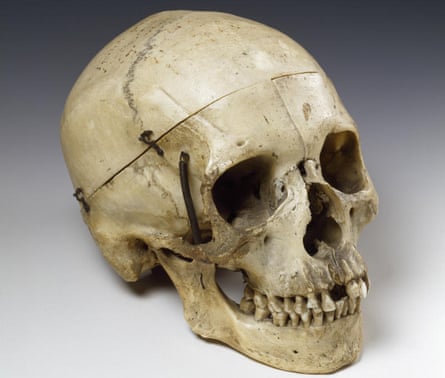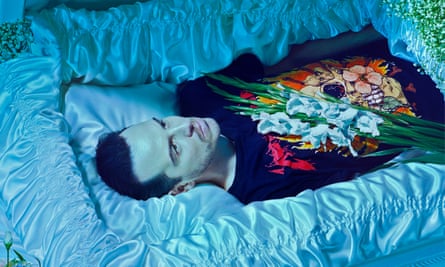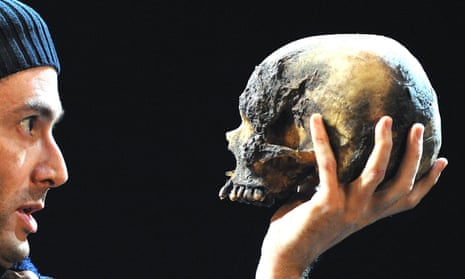Philosophical puzzle, memento mori, bleak joke on the nature of existence: interpret it however you want, but Hamlet lifting a skull is one of the defining dramatic images of all time. When Andrew Scott comes on for the graveyard scene at the Almeida later this month, in a production directed by Robert Icke, he will come face to face not only with Yorick, but with the ghosts of thousands of actors who, over the last four centuries, have done exactly the same.
No other piece of stage business has burned itself so deeply into the collective consciousness. All the greats have been there, from Richard Burbage to Thomas Betterton, Sarah Bernhardt to Laurence Olivier. Even Bart Simpson has got in on the act.
Given all this, it’s worth reflecting on the fact that, for Hamlet’s earliest audiences, seeing real human remains on stage would have been a shock. The diary of theatre manager Philip Henslowe (1550-1616), who ran the Rose on Bankside, lists any number of exotic props – among them a “snake”, a “tree of golden apples” and two “lion’s heads” – but a human skull is not among them. And as far as it’s possible to tell, no 16th-century play before Hamlet called for one.

Some have speculated that in creating the backstory of the jester Yorick, Shakespeare was paying tribute to a man called Richard Tarlton, Elizabeth I’s favourite clown and a huge star in the generation immediately before his own. Tarlton had died in 1588, so it’s theoretically possible his own cranium could have been available a decade or so later, provided Shakespeare’s company had not been too queasy about trying to get hold of it. But the props master at the Globe most likely employed the simplest option: bribing someone for access to the charnel house of a nearby church, where skeletal remains were stored.
As with so much about the early years of Hamlet’s life in the theatre, the evidence is vague, and it’s not until a century and half later that evidence of how the graveyard scene was staged begins to appear. In 1755, the critic Paul Hiffernan bemoaned the use of “real Skulls and bones in the Gravedigging Scene of Hamlet, to which a wooden Substitution might be easily made”. By the 1850s, another critic was lamenting the “highly indecent, at the same time repulsive to the audience” practice of employing human remains.
Such concerns lingered into the 20th century. After bringing a real skull into rehearsals at the National Theatre in 1975, director Peter Hall was overwhelmed by the “actuality of the scene … everybody aware of a dead man’s skull among us”. So much so that he decided not to use it in the performance. Since then, companies have experimented with wooden, plaster, papier-mache, fibreglass or plastic replicas, though as much for reasons of fragility as human dignity.

Yet even if actors or audiences are unnerved by the idea of using real remains, there seems to have been no shortage of people eager to donate their own and achieve a few moments of posthumous glory. The American actor Edwin Booth, who became a phenomenon as Hamlet on Broadway from the 1860s onwards, was reputed to have used a skull given to his actor-manager father by a notorious horse thief so desperate to appear in Hamlet that he was willing to do so even after his own death.
A similar tale concerns the barnstorming English star George Frederick Cooke (1756–1812), whose skull was reputedly retrieved from his grave and used at a one-off performance in New York in the 1860s. According to a witness – who swore to the prop’s authenticity – Cooke “enacted a great part that night”, thus stealing the show one last time. Another skull has become even more famous: signed by many of the great Hamlets of the 19th century, among them Booth, William Charles Macready, Edwin Forrest and Charlotte Cushman, it now resides in the Furness Memorial Library at the University of Pennsylvania, testament to the hazy line between real-life remains and theatrical relic.
It is a tradition that has continued up to the present day, as the story of musician and theatre-lover André Tchaikowsky attests. After Tchaikowsky’s death in 1982, it was discovered that the pianist had donated his body to medical research, with the proviso that his skull would be offered to the Royal Shakespeare Company. Mark Rylance rehearsed with it seven years later, but was unsettled by the story of its provenance, and it wasn’t until David Tennant played Hamlet in 2009 that the skull was finally used in a live performance, which provoked a minor media frenzy.

Even though the company claimed that the prop had been replaced by a replica, so as not to “distract” audiences, artistic director Gregory Doran admitted months later that Tchaikowsky had in fact starred alongside Tennant throughout. Currently, the company keeps at least four fake skulls in its props warehouse in Stratford, and would be prepared to manufacture more if a director or actor requested it.
The story of how actors have handled the skull is no less varied. The great Victorian actor Henry Irving reportedly “stroked Yorick’s skull gently with his hand”, in performances in the 1870s, while the French star Charles Fechter (1824–79) made as if to kiss it, before turning away with a shiver.
In his 1948 film adaptation, Laurence Olivier pointedly touched the skull’s cheekbone at the line “let her paint an inch thick”, and whispered bitterly in its ear at “make her laugh at that”. In a modern-dress production, Ralph Fiennes out-Fechtered Fechter, “plant[ing] his lips on Yorick’s mucky skull, as if curious about the taste of mortal soil”, in the words of the New Yorker’s critic.
So enduring – or cliched – has the symbol become that some directors have dispensed with it altogether. Thomas Ostermeier’s production, first seen at Berlin’s Schaubühne in 2008, cut the gravedigger scene entirely, merely hinting at Yorick’s presence with projected video imagery of a skull, which tracked eerily across Hamlet’s own features. When Maxine Peake played an androgynous Dane in 2014, her switch of gender was not the only transformation on offer. Instead of picking up something resembling a real cranium, the object she addressed as “Yorick” was a rolled-up beige sweater.

What will Andrew Scott do? No one’s saying, but given that his director, Robert Icke, transformed Aeschylus’s Oresteia into a kind of TV gameshow and renamed Chekhov’s Uncle Vanya “Uncle Johnny”, presumably we should expect the unexpected.
Hamlet is at the Almeida, London, 17 February to 8 April. Box office: 020-7359 4404.

Comments (…)
Sign in or create your Guardian account to join the discussion